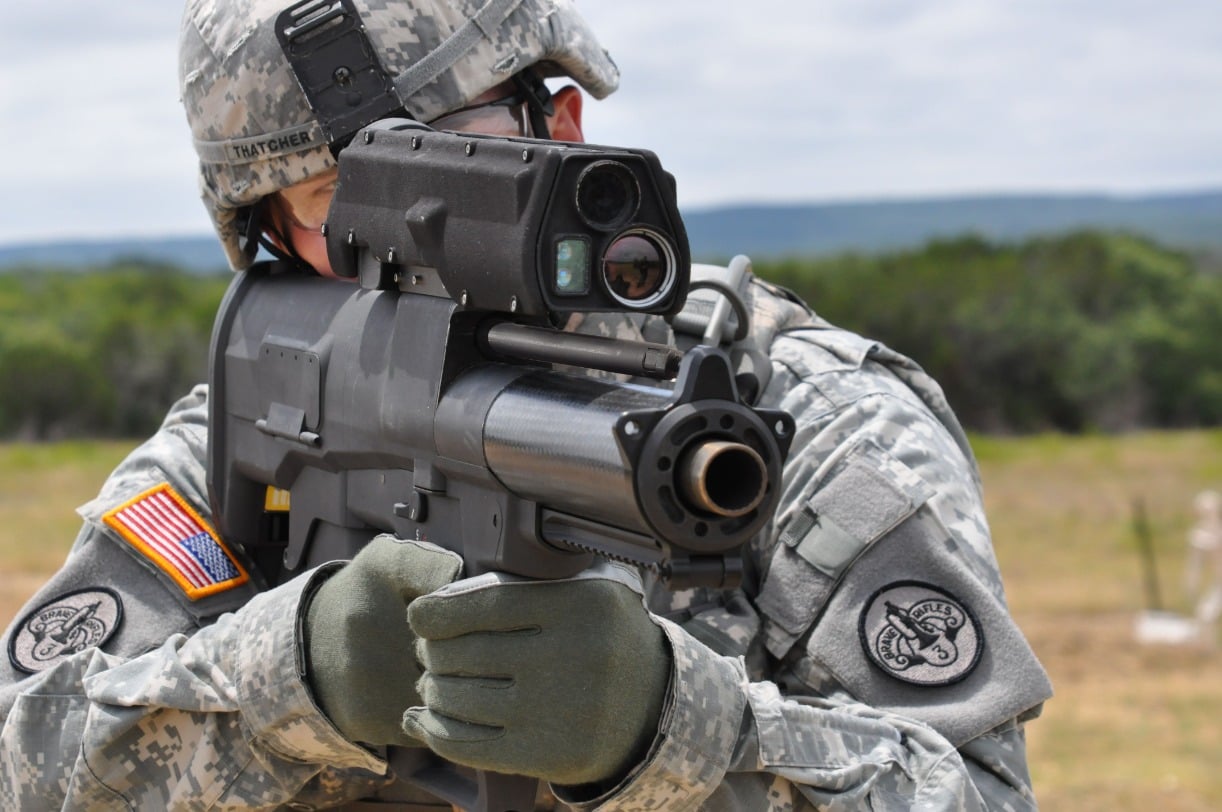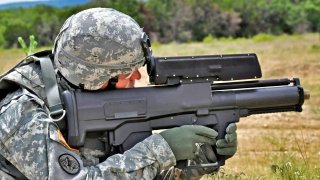Could Advanced Grenade Launchers Soon Dominate the Battlefield?
Advanced grenade launchers are emerging as potential game-changers in infantry combat, offering a blend of rifle and grenade launcher in one system. Unlike traditional single-shot launchers, these advanced systems use smaller grenades that can be aimed directly and programmed to detonate at precise distances, making them highly effective against enemies behind cover.
Summary and Key Points: Advanced grenade launchers are emerging as potential game-changers in infantry combat, offering a blend of rifle and grenade launcher in one system. Unlike traditional single-shot launchers, these advanced systems use smaller grenades that can be aimed directly and programmed to detonate at precise distances, making them highly effective against enemies behind cover.

-Despite the challenges of reducing bulk and weight, these high-tech weapons could significantly enhance battlefield effectiveness.
-While several prototypes have been developed globally, including Korea’s K11 and America’s XM29, the future of advanced grenade launchers remains uncertain as militaries weigh their benefits against conventional rifles.
Are Advanced Grenade Launchers the Future of Infantry Combat?
Could high-tech advanced grenade launchers replace conventional rifles for the infantrymen in the battlefields of the near future? Advanced grenade launchers combine a rifle and grenade launcher in one weapon with the rifle acting as backup. This idea can be traced back to 1970, and from then until now, there have been numerous incarnations of the concept.
Even just strapping a grenade launcher to a rifle is nothing new – the M203 single-shot grenade launcher attachment for the M16 and M4 has served for decades. However, the difference between the M203 and advanced grenade launchers is substantial.
Typically, advanced launchers use smaller grenades that vary between 20mm to 35mm; further, they are not single-shot designs – which have been falling out of favor. Additionally, their grenades are not necessarily arced toward the target but rather aimed directly and propelled more like a traditional bullet.
One common feature the latest systems offer is airburst. This allows the user to set the range at which the grenade will explode, meaning it is not reliant on striking something hard to detonate; this makes it extremely easy to eliminate threats behind cover. If you have an enemy at 200 yards behind a wall or in compounds, you can program the grenade to detonate at 201 meters. A soldier can then fire them over the top of the wall, and as the grenade passes, it explodes. Explosive fragmentation eliminates the enemy, and the soldiers move on. The grenade launcher can still likely punch through the cover faster than small arms fire, and while it is more lethal to the enemy, collateral damage is less likely due to the ease of detonation control.
Early Western and Soviet efforts
The Carl Gustaf company was one of the first to experiment with the concept of combining a rifle with another firearm. Carl Gustaf created the NIVA XM1970 in 1970, and it was not a grenade launcher but rather a regular rifle combined with a recoilless 45mm one.
A rough design, the NIVA XM1970 mounted over the shoulder like a recoilless rifle, and its stock allowed you to brace the gun against the shoulder. The recoilless rifle offered light anti-armor and anti-bunker capabilities. The rifle system was a 5.56mm that functioned as a bullpup. Its overall length was only 35.4 inches and it weighed 11.9 pounds.
Across the Iron Curtain, in 1975, the Soviets combined the AK-74 platform with a small 12.7mm grenade launcher. The gun had adjacent barrels and the grenade launcher was built into its left side. The grenade launcher featured a 10-round magazine beside the AK’s 30-round 5.45 magazine.
A 12.7mm grenade is relatively small, so fragmentation would be minimal but still likely offer excellent penetration through light armor and barriers at close range. Not much is known about the design, and it was never produced beyond the prototype stage.
Related: Did you know that sports influenced the design of grenades?
The PAPOP
Have you ever watched a cheap science fiction movie and seen what looks like a chunk of plastic imitating a weapon? That’s what I think of when I see the French PAPOP; the PAPOP-1, in particular, seems to be very awkward.
The French designed the system in 1995 by combining a 5.56 caliber bullpup rifle with a 35mm grenade launcher. The grenade launcher had a tube-fed design, much like a traditional shotgun. It was semi-automatic and carried three grenades at a time. The weapon featured programmable airburst shells and its aiming system was incredibly advanced using a rotating LCD screen and featuring night vision, a laser telemeter, a friend-or-foe identification tool, and a targeting computer to program grenades.
The PAPOP-2 reduced bolt and simplified the design but did not do enough to keep the system from being canceled.
XM29 Objective Individual Combat Weapon
The Americans produced the XM29 in 1996. Running until 2004, it was one of the longest-lasting programs – and an offshoot of the program even saw combat in Afghanistan.
The XM29 series combined a 5.56 rifle designed by HK with a 20mm semi-automatic, magazine-fed grenade launcher. It featured a computerized sighting system that allowed the soldier to program the 20mm grenades to airburst.
The sighting system also offered a laser rangefinder, thermal capability, and a 6X optic sight. The Army envisioned the system as a counter-defilade weapon and a replacement for the M16. However, problems were discovered in testing: The 5.56 rifle’s 9.5-inch barrel generated pitiful velocity and had poor range while the 20x28mm grenades didn’t offer the best fragmentation range. Further, the weapon was heavy, bulky, and expensive.
The weapon system was split into three groups, including a stand-alone rifle and a grenade launcher – the XM25 – which fired a larger 25x40mm grenade.
Troops in Afghanistan appreciated the weapon, but each round cost $1,000 and had to be handmade. Plans were made to order more, but budget cuts prevented the program from moving onward.
Related: Energy drinks – The unsung hero of the Global War on Terror
Advanced Individual Combat Weapon
In 2001, Australia’s Capability and Technology Demonstrator teamed up with DTSO, Metal Storm, and Tenix Defence Systems to produce a rifle and combination grenade launcher. The idea was to allow infantrymen to fire multiple grenades without having to reload, so the team combined the F88 Austeyr with a 40mm tube-loaded, three-shot grenade launcher to create the Advanced Individual Combat Weapon.
The grenade launcher used caseless ammo, which simplified the design because the ejection of a spent casing wasn’t required. The user could load grenades much like a shotgun. Although the system lacked smart grenade capability, it did succeed in its objective. Unfortunately, it weighed 22 pounds loaded with the sighting system. The program was cut shortly after development was completed.
Korea’s S&T Daewoo K11
The Korean S&T Daewoo K11 DAW is the most successful advanced launcher design that’s been created yet. The weapon’s design process started in 2006; the weapon began evaluation in the same year; and, by 2010, it was being produced. S&T Daewoo K11 DAW used a combination of a 5.56 rifle with a 20x30mm grenade. Its grenade launcher is capable of using standard and smart air-bursting grenades.
The sighting system contains a laser rangefinder as well as a ballistic computer allowing the user to easily program the smart grenades to airburst. The scope can be linked to a goggle system with a digital display and provide a thermal imaging system. The grenade launcher is semi-automatic and can hold up to six grenades in a box magazine.
The Koreans used a clever fire-selector system that allowed the user to swap between rifle and grenade launcher while using the same trigger. While I can’t speak to the effectiveness of the 20x30mm grenade launcher, the weapon has been successful. South Korea adopted the platform in 2008, and the United Arab Emirates purchased 40 K11s in 2010. Seven K11 advanced launchers even went to Afghanistan.
Nevertheless, the platform suffered from setbacks, and while several fixes were implemented by 2019, the program was canceled.
Cold Canada’s unnamed rifle
Finally, Colt Canada and the Canadian military developed an unnamed rifle system that combined a rifle with a three-shot 40mm grenade launcher that could be swapped for a 12-gauge shotgun. There is no mention of air bursts or programmable grenades. The rifle is supposed to use cased telescopic ammo, but a caliber is not mentioned.
It’s not even clear if the rifle was capable of firing or was just a mockup – although, based on the few photos that have been released, it probably wasn’t fired. The program seems abandoned, and this crazy-looking weapon never moved forward.

All of the above systems were complicated but ambitious. Combing a rifle and a grenade launcher will always be difficult since reducing bulk, weight, and size is a serious challenge. Perhaps the best step forward may be something like the XM-25 and simply making a stand-alone advanced launcher system. Time will tell if Robert Heinlein was right in Starship Troopers and grenade launchers and power armor will dominate the battlefield.
About the Author
Travis Pike is a former Marine Machine gunner who served with 2nd Bn 2nd Marines for 5 years. He deployed in 2009 to Afghanistan and again in 2011 with the 22nd MEU(SOC) during a record-setting 11 months at sea. He’s trained with the Romanian Army, the Spanish Marines, the Emirate Marines, and the Afghan National Army. He serves as an NRA certified pistol instructor and teaches concealed carry classes.


